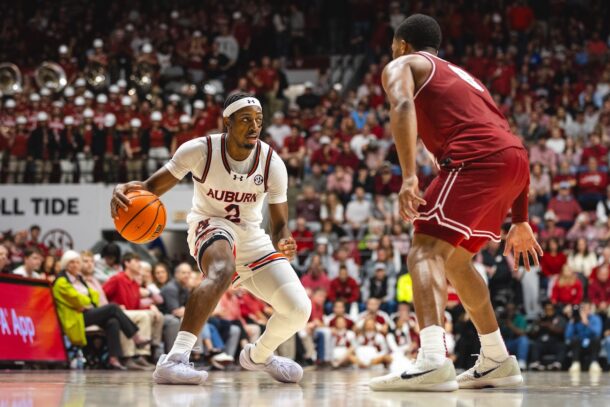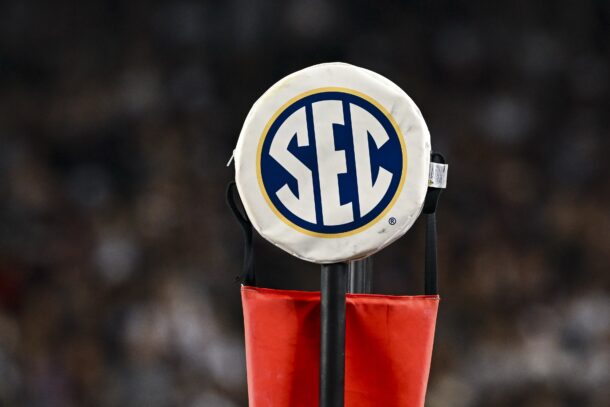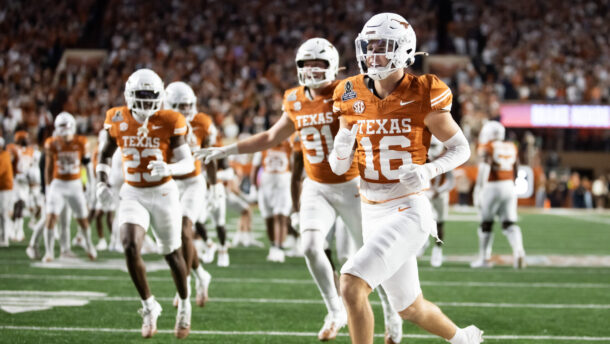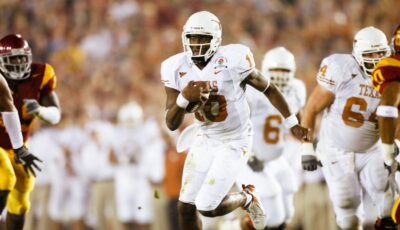
1 clear strength for every SEC basketball team entering the home stretch
The SEC men’s basketball season has just a few games remaining before the postseason.
With just under 30 games of data for most of these teams, we now have a decent sample size on all of these teams. With that in mind, let’s take a look at 1 clear strength for every SEC team at this point in the campaign.
Alabama: Tempo
This has not been the best season under Nate Oats, but the Crimson Tide are still quite formidable on offense because of their pace. They lead the country by a wide margin in that category with 76 possessions per 40 minutes, according to KenPom.
Alabama’s 3-point shooting is way down this season. But the Tide are converting 2-point looks at over 60%, which leads the country. That’s due to, at least in-part, the pace Alabama plays at both in transition and in the half-court.
Arkansas: Rim protection
Arkansas has been difficult to score on at the rim this season. The Razorbacks are 9th in the country block rate in 2024-25. Those efforts have been led by center Zvonimir Ivisic, who is averaging 2.1 blocks in just 20 minutes per game.
Beyond blocks, Arkansas also does a good job of limiting makes inside the paint. Per CBB Analytics, Arkansas opponents shoot 5% worse in the paint when compared to the Division I average. Teams are also shooting a below-average percentage against the Razorbacks on shots at the rim this season.
Auburn: Ball security
Look, it would be much easier to list Auburn’s weaknesses than it would be to go down its ever-growing list of strengths. Auburn is good at virtually everything — that’s why it’s arguably the No. 1 team in the country. But at the very top of the list is ball security.
Auburn ranks No. 4 nationally in offensive turnover rate, per KenPom. The Tigers turn the ball over on just north of 13% of their possessions. That’s a great recipe for maximizing an offense that’s already hyper-efficient. It’s also an ideal profile for winning in March.
Florida: Lineup versatility
Like Auburn, Florida has a number of strengths to choose from when it comes to its statistical profile. Offense, defense, it doesn’t matter — the Gators are good at everything. With that in mind, Florida’s lineup versatility and depth stand out.
Of the SEC’s 5 best 3-man lineups this season (min. 500 possessions), the Gators have 3 of them, per data from EvanMiya.com. Will Richard is the only constant across the 3 lineups with players like Thomas Haugh, Walter Clayton Jr., Alijah Martin and Rueben Chinyelu also appearing in those highly-efficient groups. Each one of those 3-man lineups has outscored other teams by more than 30 points per 100 possessions (adjusted for opponent strength) per EvanMiya. That kind of versatility can go a long way in March when you could see wildly-different styles within the same weekend.
Georgia: Height
Georgia is an unusually-big team by college basketball standards. According to KenPom, the Bulldogs clock in at No. 11 nationally with an average height of nearly 6-8 — more than an inch and a half taller than the Division I average.
The Bulldogs don’t play anyone shorter than 6-4 in their rotation and have a couple of 6-11 bigs — Asa Newell and Somto Cyril — patrolling the paint. That size has translated to a 15% block rate, which ranks 10th nationally.
Kentucky: 3-point shooting
Kentucky has one of the best offenses in the country this season in Year 1 under Mark Pope. The Wildcats play fast and make a ton of 3-pointers, which has been especially true in conference play. UK has made north of 40% of its 3-point tries during SEC action, which is 1st in the league to this point in the season.
Koby Brea, Jaxson Robinson and Ansley Almonor are all hitting over 40% of their 3-pointers vs. SEC opponents, with Robinson and Almonor north of 47%. Only 8 players in the SEC can say that (min. 45 attempts) and Kentucky has 3 of them.
LSU: 3-point attempt prevention
It’s no secret that this has been a disappointing season for Matt McMahon and LSU. It’s difficult to find clear strengths for a team that’s 3-11 in conference play. But the Tigers have done a good job of limiting 3-point attempts by their opposition all season.
LSU opponents have a 3-point attempt rate of just 34.7% this season, which ranks in the top-50 nationally. The Tigers have been able to keep that up through SEC play despite the poor performances overall. That has contributed to LSU having the 29th-best effective field goal percentage defense this season.
Mississippi State: Defensive havoc
Mississippi State’s defense has produced some mixed results this season, but you can’t fault them for effort. The Bulldogs cause plenty of havoc on the defensive end as they rank in the top-25 nationally in both defensive block rate and steal rate.
Fifth-year senior Cameron Matthews is a big reason why. He’s averaging an SEC-best 2.5 steals per game and is also chipping in 0.8 blocks a night. Mississippi State has perhaps given up a few too many good looks from 3-point range as a result of their aggressive style (297th in 3-point defense) but there’s always a give-and-take on the defensive end of the floor.
Mizzou: Free throw attempt rate
Mizzou’s entire offense is elite, but if I’m going to pick out one part of this profile, it’s the free throw rate. The Tigers practically live at the charity stripe — they’re 2nd nationally in that category according to KenPom. Unfortunately, some of it is wasted with a free throw percentage of just 72% on the year.
Mark Mitchell and Anthony Robinson have both already taken over 100 free throws this season with Tony Perkins and Tamar Bates not too far behind. Mizzou is constantly putting defenses in difficult positions that often result with either a good look from 3-point range or a trip to the foul line. That’s how you play efficient basketball in 2025.
Oklahoma: 3-point shooting
For a team that has wins over Arizona, Michigan, Louisville, Mississippi State and Arkansas on its résumé, it’s surprisingly-hard to find a clear strength for Oklahoma. The Sooners don’t have any glaring weaknesses either (besides rebounding, perhaps), but not much stands out with regards to obvious advantages.
One thing you could point to is 3-point shooting. Jalon Moore, Duke Miles and Brycen Goodine are all shooting above 38% from 3-point range this season. They’ve been reliable release valves for Jeremiah Fears’ rim pressure this season. The strong 3-point shooting really determines what OU’s ceiling is. This isn’t rocket science, but Oklahoma shoots 44% from 3-point range in its SEC wins and 32% in its SEC losses. That’s a much wider gap than you’d see from the average team in this league (37% to 30%).
Ole Miss: Turnovers
Remember how Auburn was No. 4 nationally in offensive turnover rate? Well, Ole Miss is No. 1. The Rebels turn the ball over on just 12.8% of their offensive possessions. Somehow, that number dips slightly lower to 12.6% during SEC play.
Defensively, Ole Miss is also very good at forcing turnovers. The Rebels 3rd in the SEC in defensive turnover rate so far this season. That’s good for a +4.4 turnover differential per game in 2024-25 against SEC opponents. Since 2017-18, only 1 other team (Mizzou in 2022-23) has a better turnover differential per game in conference play, per Radar360.
South Carolina: Free throw rate
South Carolina takes a lot of free throws and doesn’t give many away. Unfortunately, that’s roughly the extent of the positive things you can say about the South Carolina statistical profile in 2024-25.
Per KenPom, South Carolina is 3rd in the SEC in offensive free throw rate and 1st in defensive free throw rate. South Carolina’s free throw attempt differential of +5.9 in SEC play is the best in the league so far this season and the 5th-best since 2017-18.
Tennessee: Interior defense
The Vols do an unbelievable job on the defensive end of the floor, but it really shows up on the interior. Tennessee boasts a defensive block rate of 17.3%, which ranks 3rd nationally. The Vols are also 11th nationally in 2-point percentage defense.
Per CBB Analytics, teams are shooting just 53% at the rim this season against the Vols. That’s well below the DI average of 62%. That — plus great defense at the 3-point line as well — has translated to a nation-leading effective field goal percentage defense of 43.5%.
Texas: Isolation scoring
Texas is one of the few teams in this league without an obvious strength, but the Longhorns do have a superstar freshman in Tre Johnson who is responsible for a big chunk of their offense. Johnson is a very talented scorer who is shooting good percentages all over the floor this season.
However, Texas isn’t exactly running an offense that’s similar to the beautiful-game Spurs. The Longhorns are 262nd nationally and 15th in the SEC in assist rate. A lot of their offense comes from self-creation, for better or worse. Adjusted for opponent strength, Texas has KenPom’s 42nd-most efficient offense in the country overall this season. Not bad, but far from elite.
Texas A&M: Offensive rebounding
This is perhaps the easiest advantage to point out in the entire SEC, if not the country. The Aggies lead the nation in offensive rebounding rate at nearly 42% this season. The extreme effort and commitment to the offensive glass helps to make up for the fact that Texas A&M is just 305th nationally in effective field goal rate.
Arguably the most impressive thing about A&M’s offensive rebounding rate is that it’s a true ensemble effort. There’s no Zach Edey in the middle to gulp up all the rebounds. Pharrel Payne is the closest, but even his offensive rebounding rate ranks just 64th nationally amongst qualified players. It’s an exhaustive team effort and is the primary reason why A&M has a top-20 team this season.
Vanderbilt: Mid-range shooting
Vanderbilt has been pretty average on both sides of the floor this season (albeit better on offense than defense), but there’s 1 area where the Commodores stand out: mid-range shooting. The death of the mid-range shot at all levels of basketball has been well-documented in recent years, but not so much in Nashville.
Vandy is shooting 40.5% on mid-range shots this season, which is about 5% better than the national average. The Commodores are also better than the average DI team at non-rim paint attempts, per CBB Analytics. According to BartTorvik, Vanderbilt’s best mid-range shooter this season (on significant volume) has been Jason Edwards at over 47%. This would be an even bigger strength for Vandy if AJ Hoggard (23-of-75) would cut out those attempts.
Spenser is a news editor for Saturday Down South and covers college football across all Saturday Football brands.







